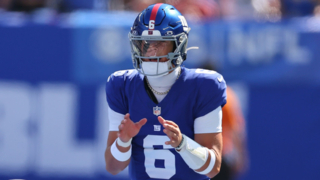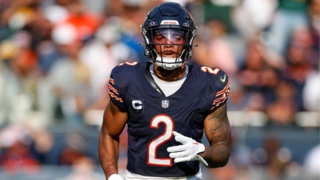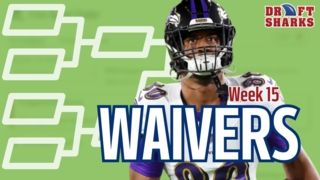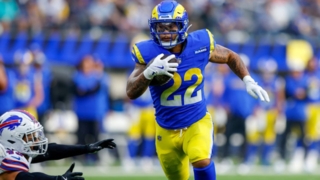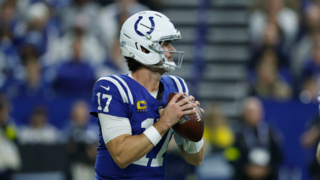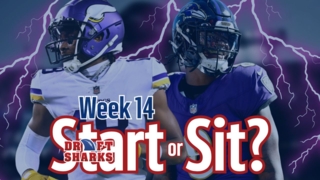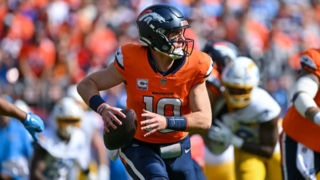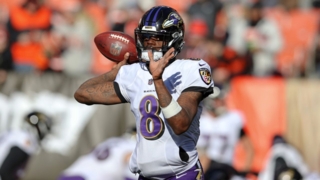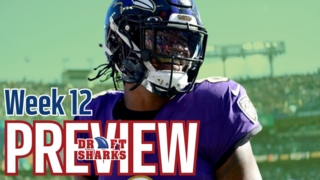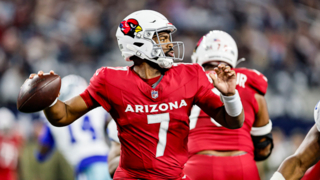In This Article
2022 QB Strength of Schedule

There’s a highly drafted QB – with even more highly drafted WRs – who just might face a brutal close to his schedule.
There’s an upside QB going late in drafts who might be unusable come fantasy playoffs time.
And there’s a near-forgotten QB whose schedule finish looks excellent.
We’ll get to all 3 … and much more. But first, the path.
Strength of Schedule
The primary thing I’ve found through several years of trying to project QB strength of schedule is that no single stat (at least that I’ve uncovered) does a good job of carrying over year to year and revealing good/bad matchups. We see wide swings every year. Sometimes injuries take hold. Sometimes it’s sheer luck, with TD rates and/or INT rates swinging otherwise modest points totals. Some defenses prove efficient vs. high pass-attempt totals. Others prove generous on fewer attempts. And even the attempt volume hasn’t been sticky.
What I have settled on over the past couple of years is passing fantasy points allowed per pass attempt (PFP/PA) as a decent measure. And it makes intuitive sense.
We strip away the rushing production, which can depend heavily on the QB and TD luck. Not every defense faces Lamar Jackson … while others get him twice. The Chiefs allowed the 2nd most QB fantasy points last season, but ranked just 14th in passing fantasy points allowed per attempt. Jackson’s 107 yards and 2 scores on the ground in Week 2 played a large role in that difference.
Additionally, breaking it down by attempt allows us to better compare teams such as Seattle and Chicago. The Seahawks allowed 28.1 more passing points for the season, but they also faced 181 more attempts.
The quality of those 2 defenses is more likely to carry over into 2022 than the specific attempt totals.
Last Year’s Picks
The goal here is to project positive and negative QB-scoring matchups for the coming season. Let’s see how I fared in making those picks last year, with passing points per attempt as the driver …
Positive
Atlanta (8th most passing points allowed per attempt)
Cincinnati (18th)
Detroit (2nd)
Houston (6th)
Jacksonville (7th)
Las Vegas (31st)
Pretty good overall, and even the 2 bad outcomes here still don’t look like terrible picks in hindsight. The Bengals finished last season just 24th in Football Outsiders pass-defense DVOA, and the Raiders checked in 21st. So neither was actually a good pass defense, and neither motivated us to bench QBs last season. Cincinnati managed to finish below the league average in passing-TD rate, while the Raiders proved generous to ground scoring (6th most RB rushing TDs allowed on 14th most carries faced).
Negative
Baltimore (4th most passing points allowed per attempt)
Denver (25th)
L.A. Rams (10th)
New England (24th)
Pittsburgh (20th)
Washington (3rd)
The biggest misses here were obviously Washington and Baltimore. The Ravens struggled with injuries throughout their secondary. That included losing CB Marcus Peters to an ACL tear before the season and CB Marlon Humphrey to a pectoral tear in early December. The leading corner in playing time was Anthony Averett, who the team has since let walk in free agency.
Washington dealt with some injuries as well, but the defense also just stunk.
The Rams didn’t prove as stingy as expected on fantasy points, but they delivered the league’s #6 defense in passing DVOA. So it was a good unit.
I’ve kept all of this in mind for projecting 2022 …
Looking Ahead
In the past, I’ve limited this to 6 picks for each group. I’m going to expand that this year, breaking the league into 3 nearly equal parts. I know I’ll never get all the picks right, but I’m following trends and offseason moves to try to capture more upside and downside matchups.
Here are my best guesses at the 10 most positive and most negative matchups for QB scoring …
Positive
Atlanta
Chicago
Cincinnati
Dallas
Detroit
Houston
Jacksonville
Kansas City
Minnesota
Washington
Despite sporting 1 of the league’s top young CBs in A.J. Terrell, the Falcons ranked just 29th in passing DVOA last season. That marked the 3rd time at 25th or worse in the past 4 years. They, Detroit and Houston are easy selections.
The Bears were tough in pass D as recently as 2019. But they went from 4th toughest in PFP/PA that season to 20th in 2020 and then last in 2021. Then they traded away EDGE Khalil Mack. And it looks like Chicago will trust 2 of its top 5 secondary spots to rookies. This looks like a defense that won’t scare any QBs.
Washington has the talent to rebound. But DE Chase Young is coming off an ACL tear. And the secondary doesn’t contain a game-altering player. So I’ll start out betting against it.
The Bengals seemed to prove me wrong last year. But as I mentioned, they finished 24th in pass DVOA. So it wasn’t actually a good pass defense. With no big changes in personnel and an offense that looks ready to create some shootouts, I’ll keep betting on Cincinnati games as positive settings for our fantasy QBs.
Minnesota and Kansas City were a little tougher. The Chiefs, though, have ranked better than 12th in pass DVOA just once over the past 5 years. Last season matched the team’s worst ranking in that category since Andy Reid arrived. And then K.C. let DB Tyrann Mathieu, CB Charvarius Ward and CB Mike Hughes walk.
The Vikings have trended away from its days as a top-shelf pass defense. The past 2 versions allowed the 6th and 12th most PFP/PA. The Vikings hit 2022 with a new scheme under a new coaching staff for the 1st time since 2014. The pass rush has plenty to prove, and the secondary might be starting a pair of rookies.
Dallas might seem like the oddest inclusion, but there was a lot of mirage to last year’s defense. The team allowed the 7th-lowest passing-TD rate and produced the 2nd-highest INT rate. Despite ranking 3rd-best in completion rate allowed, the Cowboys yielded the 14th most yards per attempt. Even breakthrough CB Trevon Diggs graded just 80th at the position in coverage, according to Pro Football Focus. Throw in an offense with shootout potential, and there’s plenty of upside to this matchup.
Neutral
Arizona
Carolina
Cleveland
Indianapolis
L.A. Rams
Las Vegas
N.Y. Giants
N.Y. Jets
Philadelphia
San Francisco
Seattle
Tennessee
The Jets began this process in the “positive” section. But they allowed the 5th fewest PFP/PA last year. Then they spent 2 first-round picks on CB Sauce Gardner and EDGE Jermaine Johnson. They’ll also get EDGE Carl Lawson back from an Achilles’ tear. Free-agent S Jordan Whitehead isn’t a scary coverage defender, but sheer stability at the position will be an upgrade for a defense that struggled at safety after Marcus Maye went down in Game 6.
Negative
Baltimore
Buffalo
Denver
Green Bay
L.A. Chargers
Miami
New England
New Orleans
Pittsburgh
Tampa Bay
The Ravens ranked among the 3 toughest defenses in PFP/PA for 4 straight seasons before last year’s tumble. I’ll go back to being hesitant with them.
Denver, Miami, New England, Tampa Bay and Buffalo all ranked 25th or lower in most PFP/PA allowed in 2021. Green Bay has finished 21st or lower 3 straight years and gets a healthy Jaire Alexander after missing him for most of last season. Pittsburgh ranked 24th, 29th and 20th the past 3 years.
New Orleans got friendly as a PFP/PA defense last year (5th most allowed), but that marked a significant difference vs. the previous 7 seasons. But the Saints remained a good defense, ranking 3rd in DVOA and 4th against the pass. They added Mathieu in free agency and should sport a healthier pass rush.
The Chargers have been a middling pass defense the past 4 years, but they went for it this offseason. L.A. signed the top available CB, J.C. Jackson, and traded for EDGE Khalil Mack. I’ll buy significant improvement.
The Schedule
Before we get to the grid, keep in mind that I’m not telling anyone to avoid the red weeks altogether. I’ll get some picks wrong. Players will outperform tough matchups. Guys will deliver fantasy numbers even while enduring a bad game. And stars will disappoint.
Consider the red spots more “proceed with caution” than “stop.”
And the green spots aren’t magic. A crappy QB doesn’t become a must-start even in the best matchup.

16-Game Factor
I tallied up the positive matchups for each team and multiplied that by 1.136, the average impact of the 10 most generous QB matchups vs. median annual scoring over the past 9 years. Then I tallied the negative matchups and multiplied by 0.8845, the average impact of the bottom 10 defenses over the same span.
The “factor” calculation comes from combining those 2 results and adding 1 for every “neutral” matchup.

Now back to the passers from the beginning of the article …
Bengals QB Joe Burrow gets a tough finish. There’s lots of best-ball stacking of him, his WRs and Bills, centered on that Week 17 Cincinnati-Buffalo matchup. There’s nothing wrong with that approach. But relying heavily on Burrow and either of his top 2 wideouts could hurt your season-long, lineup-setting team when he travels to Tampa Bay in Week 15 and then New England in Week 16.
I’m not saying don’t draft Burrow because of that. But be aware of the looming matchups, especially as fantasy-playoff time approaches.
Dolphins QB Tua Tagovailoa matters less than Burrow, because his ADP can’t climb out of low QB2 range. He certainly doesn’t look like a league-winning pick with road games against the Chargers, Bills and Patriots among the final 4 weeks in most leagues.
On the positive side – and even lower than Tagovailoa in ADP – Titans QB Ryan Tannehill gets home dates with Jacksonville, Houston and Dallas among the final 4 fantasy weeks. If he (and Derrick Henry) hit that stretch healthy, there’s room for some Titans to be involved in title decisions.
17-Game Factor
Same deal as above, but I’ve included Week 18 … in case your league plays that far.
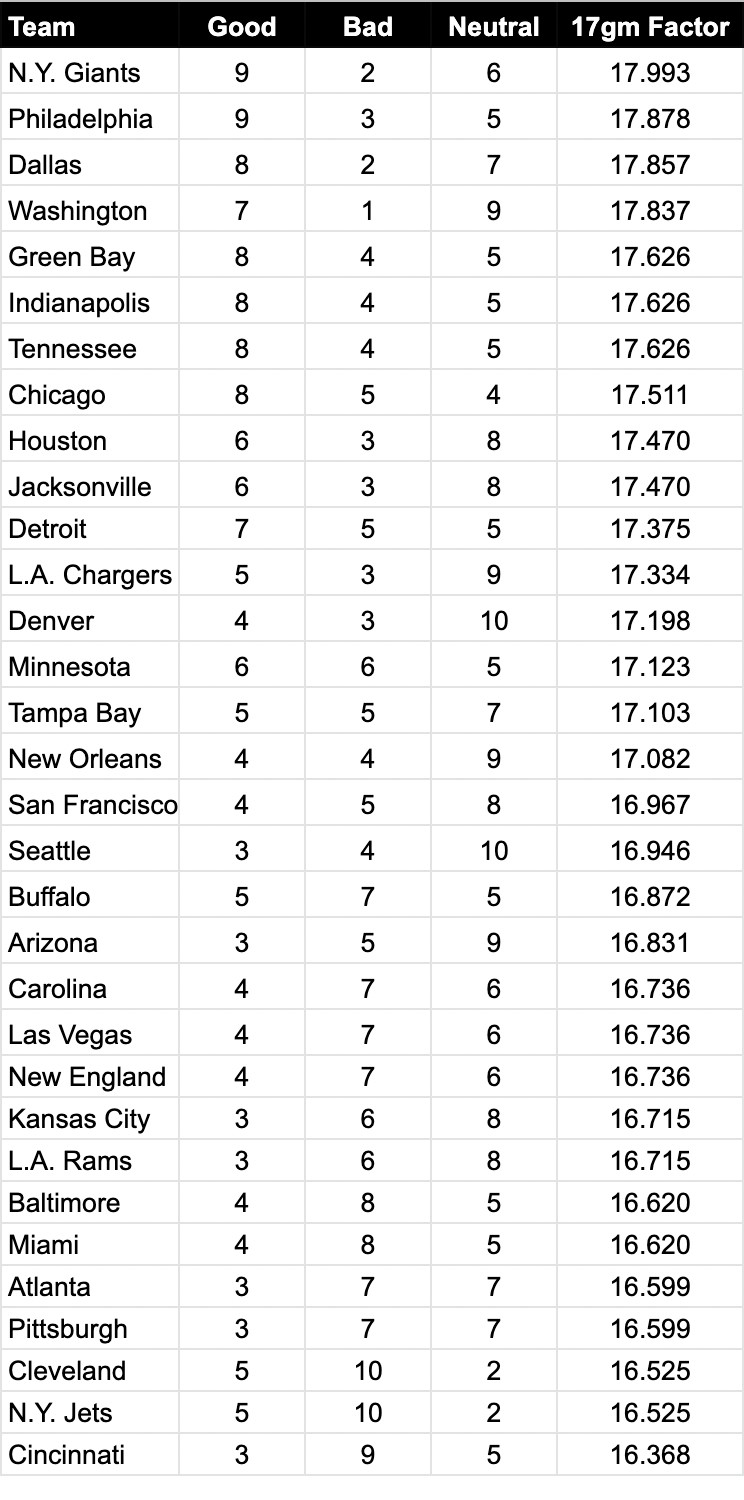
Draft using the best dynamic tool in the industry. Our fantasy player valuations (3D Values) change during your draft in response to...
- Exact league settings - direct sync
- Opponent and Team Needs
- Positional scarcity & available players
- Ceiling, injury risk, ADP, and more!
You need a dynamic cheat sheet that easily live-syncs with your draft board and adapts throughout your draft using 17 crucial indicators.
Get your Draft War Room Today
 Redraft
Redraft Dynasty
Dynasty Best Ball
Best Ball
